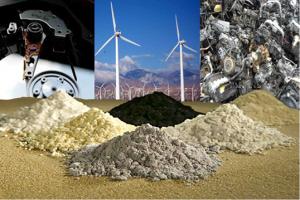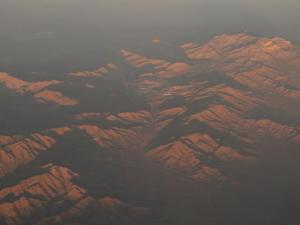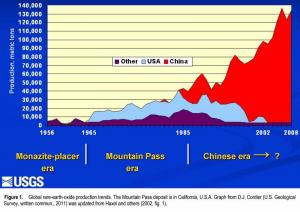Rare earths, coal ash options considered amid trade-war talks
Chinese dominance in an obscure field of rare earth mining has surfaced during heated trade talks between China and the United States, but even though trade tensions have since eased, U.S. dependence on mining minerals critical to modern society has not.
As U.S. companies seek other ways to find rare earths, one potential source is something the Cape Region has plenty of – coal ash.
The Indian River power plant for years produced coal ash, a by-product of its coal-to-fuel-generated power. A mound of coal ash remains next to the plant, now capped with vegetation and rip-rapped with rock and other stabilizing materials that officials say will keep it from washing away and turning Indian River into a toxic coal sluice.
The Indian River power plant, now owned by NRG, began dumping coal ash next to the Millsboro power plant in 1957 when it was operated by Delmarva Power & Light. The dump was closed in 1979 when a new, state-of-the-art landfill was built at the Indian River facility.
In a previous interview, an NRG spokesman said the company does not know how much coal ash was deposited on Burton Island – a slip of land next to the power plant bordered by Indian River. Past environmental studies of Indian River near Burton Island found elevated levels of selenium and acceptable levels of arsenic.
But coal ash contains more than toxic substances. Neodymium, dysprosium, yttrium and scandium – four of 17 elements considered rare earth elements – are used to make magnets, batteries and catalysts used in today's cellphones, flat-screen TVs, computers, fighter jets and other crucial technology.
A September article in the U.S. Geographical Survey states research into extracting rare earth elements – known as REEs – from coal ash continues, but more research is needed.
“Viable recovery of rare earth elements from coal and coal ash requires identification of coals and ashes with the highest REE concentrations and development of workable methods for REE extraction and recovery,” the article states. “Understanding how REEs occur within fly ash … is one of the keys to developing possible methods for their recovery.”
The article also said China produced more than 70 percent of global REEs in 2018, a drop from a high of 95 percent reported in 2010. Even before the dawn of the 21st century, the U.S. has depended on China for rare earth elements, but the Trump administration wants to change that.
A U.S. Commerce Department report released in June stated the U.S. needs to reinvest in its National Defense Stockpile program to make sure minerals critical to today's society and national defense remain available.
“The United States is heavily dependent on critical mineral imports. If China or Russia were to stop exports to the United States and its allies for a prolonged period - similar to China’s rare earths embargo in 2010 - an extended supply disruption could cause significant shocks throughout U.S. and foreign critical mineral supply chains,” the report states.
Secretary of Commerce Wilbur Ross also weighed in on the need for rare earth elements.
“These critical minerals are often overlooked but modern life without them would be impossible,” Ross said in a statement. “Through the recommendations detailed in this report, the federal government will take unprecedented action to ensure that the United States will not be cut off from these vital minerals.”
Alternative use of coal ash sought
In West Virginia, where coal-powered plants contribute about 30 percent of the nation's electric power generation and an annual total of nearly 80 tons in coal ash waste, studies are underway to separate rare earth elements from coal mine sludge. In Kentucky, researchers backed by U.S. Department of Energy funding have developed a process that filters out 80 percent of rare earths from coal ash, according to a 2018 Chemical & Engineering News publication.
University of Delaware Professor Dr. Saleem Ali said government funding is key to developing technology in order to separate rare earths from coal ash. But without government subsidies, he said, the business world is not likely to invest in pricey technology to separate materials.
“If there were government subsidies provided to allow companies to get the metals at lower cost, they might consider it,” he said. “The levels in coal ash are not at the levels that would be economically feasible to extract.”
Besides, Ali said, the amount of rare earths that could be derived from coal ash is not enough to make magnets needed for wind turbines, for example, or to make laptop screens.
“The volume you need for that, you couldn't get from coal ash,” he said.
The process to separate the elements is also very messy, Ali said. Chemical solvents and a lot of energy are needed to complete the process. “You have to do all kinds of nasty things to get them out, so you have to think about whether that is worth the investment,” he said.
Location is another factor to consider. If the coal ash is located in a densely populated area, bringing in chemicals may not be a good idea, he said. “But if it's not a biodiverse area or not a sensitive ecosystem, it may be OK,” he said. “You have to think of it from a systems perspective and what makes the most sense.”
Even if the investment is made to build a factory to separate rare earths from coal ash, Ali said, that technology could be obsolete in 20 years.
Dave Schrader, public relations manager for NRG, said there is currently no effort to remove rare earths from the coal ash at the Millsboro power plant.
Ali said it makes more sense to use coal ash for building or construction material. “We want to minimize waste, so if that ash can be put to use in terms of building material, that has more potential,” he said. “You can use more of it, and it gets things done. A lot of our roads need repair. If you can use coal ash in that, I think it's a good idea.”
Closer to home with an added bonus of reducing landfill waste, Ali said, recycling electronics and removing all rare earths from inside discarded items is another potential source of rare earths. “We should certainly be recycling more of our electronic equipment,” he said.
As for rare earth mining, recent reports state the only U.S. rare earth mine, located in California, has been hiring more employees with plans to boost production in 2020. The Mountain Pass mine owned by MP Materials also plans to restart a dormant refining factory with a $200 million cash infusion. About 50,000 tons of earth is mined each year at the facility, but it is shipped to China for processing, according to published reports. Ali said the amount of rare earths that come from mining is far greater than what could be found in coal ash.
Other potential rare earth deposits are being explored on the ocean floor. A Nov. 17 “60 Minutes” report highlighted a multi-nation effort to harvest minerals in a 2 million-square-mile area between Hawaii and Mexico, known as the Clarion Clipperton Zone. Several countries including China, Russia and Australia have secured permits from the United Nations-controlled ocean area to conduct mining expeditions there.
At the same time, the U.S. is looking to strengthen ties with Australia in an effort to acquire rare earths. On Nov. 18, the U.S. and Australia announced that they were expanding their existing memorandum of understanding by collaborating on research and increasing critical mineral capacity for both countries.
“We are working with our close international partners and allies to carry out President Trump’s blueprint to position the United States as a leader in the critical minerals sector and ensure economic prosperity,” said Secretary of the Interior David Bernhardt. “This is an important milestone in reducing the nation’s susceptibility to critical mineral supply disruptions.”
RARE EARTHS AND ELEMENTS
Chinese dominance in rare earth element mining may have peaked in 2010 when China controlled about 95 percent of the world’s rare earth production, according to Geoscience News and Information.
At the same time, prices for rare earths have also risen more than 500 percent.
Though not exactly household names, rare earths are critical to today's society and particularly to the country's national defense. Some elements and their uses include:
• Yttrium – television, computer and other devices that have visual displays
• Europium – color TVs and fluorescent lamps, computer monitors and control rods in nucluear reactors
• Cerium – catalytic converters, oil refining
• Lanthanum – night-vision goggles, studio lighting and cinema projection
• Neodymium – wind turbine magnets, laser range-finders and guidance systems, and magnets for loudspeakers and computer hard drives
• Erbium – amplifiers in fiber-optic data transmission
• Samarium – magnets that are stable at high temperatures, precision-guided weapons and stealth technology
• Scandium – aluminum-alloy baseball bats, semiconductors and specialty lighting
Source: BBC
Melissa Steele is a staff writer covering the state Legislature, government and police. Her newspaper career spans more than 30 years and includes working for the Delaware State News, Burlington County Times, The News Journal, Dover Post and Milford Beacon before coming to the Cape Gazette in 2012. Her work has received numerous awards, most notably a Pulitzer Prize-adjudicated investigative piece, and a runner-up for the MDDC James S. Keat Freedom of Information Award.


























































